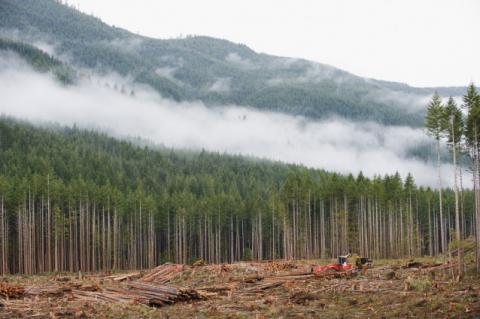Canada Tops The World In Forest Degradation Thanks To Climate Change, Logging And Energy Development
Canada leads the world in forest degradation, according to a new mapping project.
The project, put together by World Resources Institute, Greenpeace and multiple other groups, uses interactive maps to display forest degradation and destruction around the world between 2000 and 2013. According to WRI, more than 104 million hectares (about 401,546 square miles) — a chunk of land the group notes is three times the size of Germany — of the world’s remaining large, undisturbed forests, or Intact Forest Landscapes, were degraded in the last 13 years. The Northern boreal region of Canada, Russia and Alaska had some of the largest area of degraded forests, with the Amazon having the second-largest and the Congo basin the third.
In Canada’s tar sands region, forest fires and industrial development have destroyed or degraded almost two million acres of boreal forest since 2000, according to Peter Lee, Director of Global Forest Watch Canada. Lee told ThinkProgress in an email that Canada’s main driver of forest destruction is an “increased frequency and extent of forest fires” driven by climate change. These fires are likely converting areas that were once heavily forested into shrublands. Logging and road-building are the second-biggest causes of forest destruction and degradation, Lee said, and “massive increases in the pace and scale of energy developments, especially non-conventional oil and gas developments in northern Alberta’s tar sands region and also in north-eastern British Columbia with the shale plays,” is the third.
In order to mine for tar sands in Canada’s boreal region, swaths of boreal forest are cut down, and according to the Sierra Club, none of the land altered to make way for tar sands mining has been “certified as reclaimed” by Alberta, Canada’s government. Canada’s boreal forests serve as key breeding habitat for 292 species of protected birds, according to a June report, and tar sands development has resulted in the death of thousands of these birds.
In the end, though, the main reason Canada is the top country in terms of forest degradation is that it still has so many intact forests, Lee said. According to WRI, nearly 95 percent of the planet’s remaining large, Intact Forest Landscapes are found in boreal and tropical regions. There’s also a “lack of of political interest in conserving virgin forests” among Canada’s federal and provincial governments, Lee said.
“Most logging done in Canada is still to this day done in virgin forests,” Lee told the Edmonton Journal.
But though the world’s boreal region is experiencing the greatest forest degradation, deforestation and degradation are still major problems in the tropics. In Malaysia’s Cameron Highlands, WRI notes, forests are being cleared “at an unprecedented rate…not only for housing, shops and hotels, but also for vegetable and flower farms.” In the last decade alone, the average temperature in the region has risen 2°C. That rise could have been exacerbated by deforestation, and other regions with high rates of deforestation could experience a similar rise — one study projects that the Congo Basin could rise in temperature by 3°C by 2050, due to deforestation.
In the U.S., the Southeast is the most active region for forest generation and loss. According to WRI, the Southeast is the most heavily-forested region in the country, home to 29 percent of the country’s total forested land. Many of the region’s forests are used as crops for timber or paper production, so total forested area regularly waxes and wanes as crops are grown and harvested every five years.
Leaders of the groups that put together the mapping project say the results of should make governments take note of the dangers of forest degradation.
“Governments must take urgent action to stop IFL degradation by creating more protected areas, strengthening the rights of forest communities and other measures that protect intact forests for their economic, social and conservation values,” Christoph Thies, Senior Forest campaigner for Greenpeace International said in a statement.


Spread the word